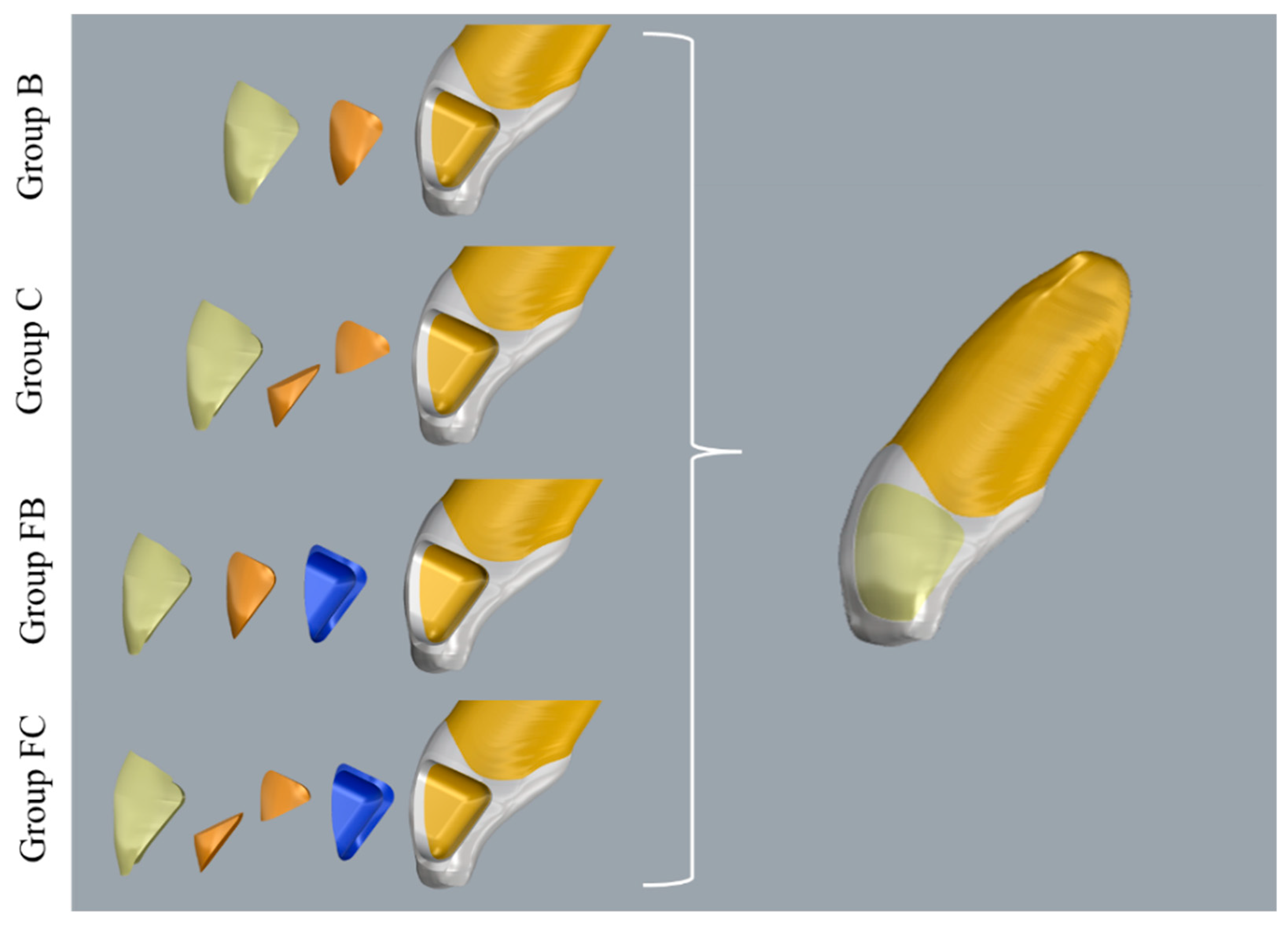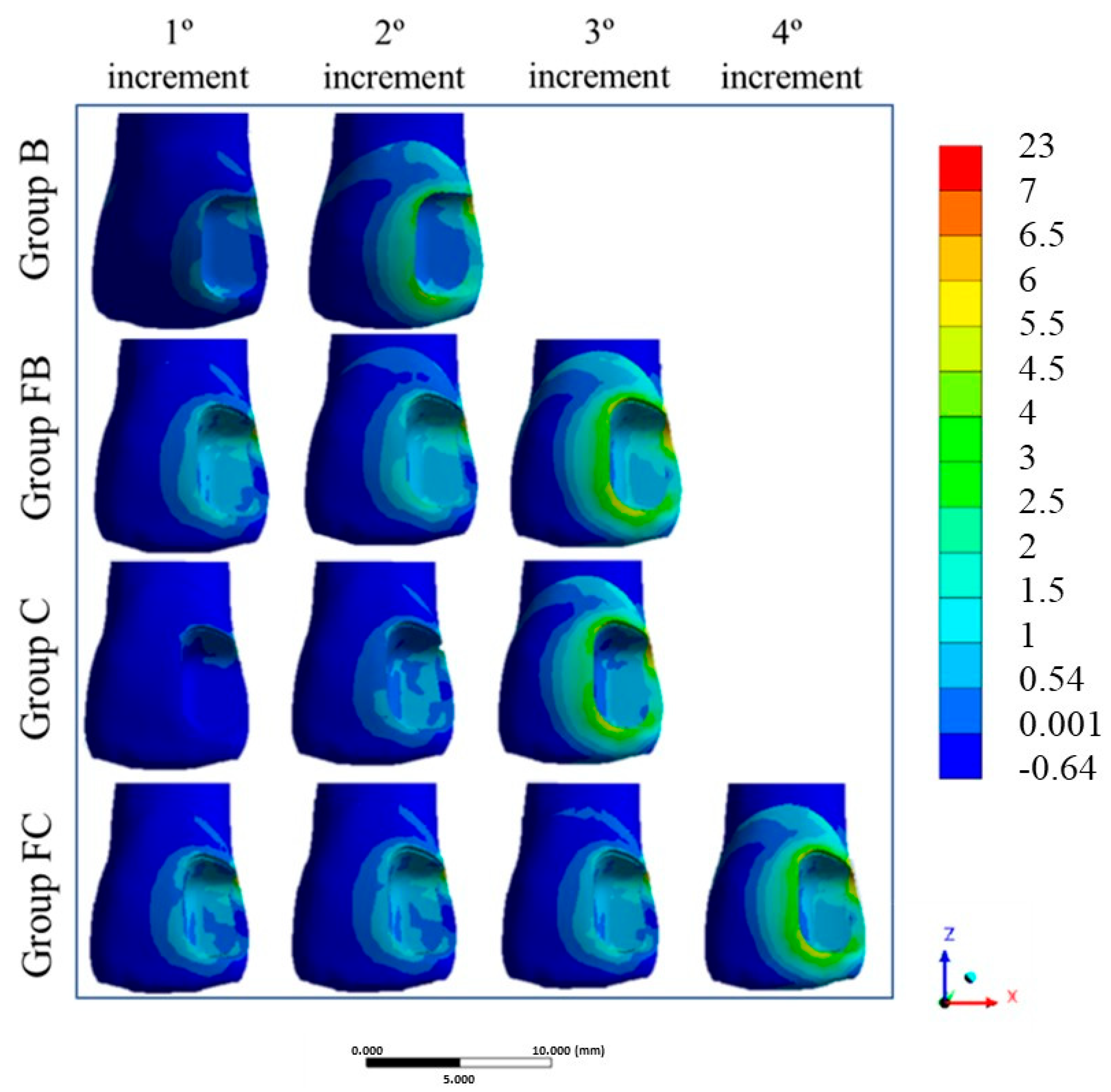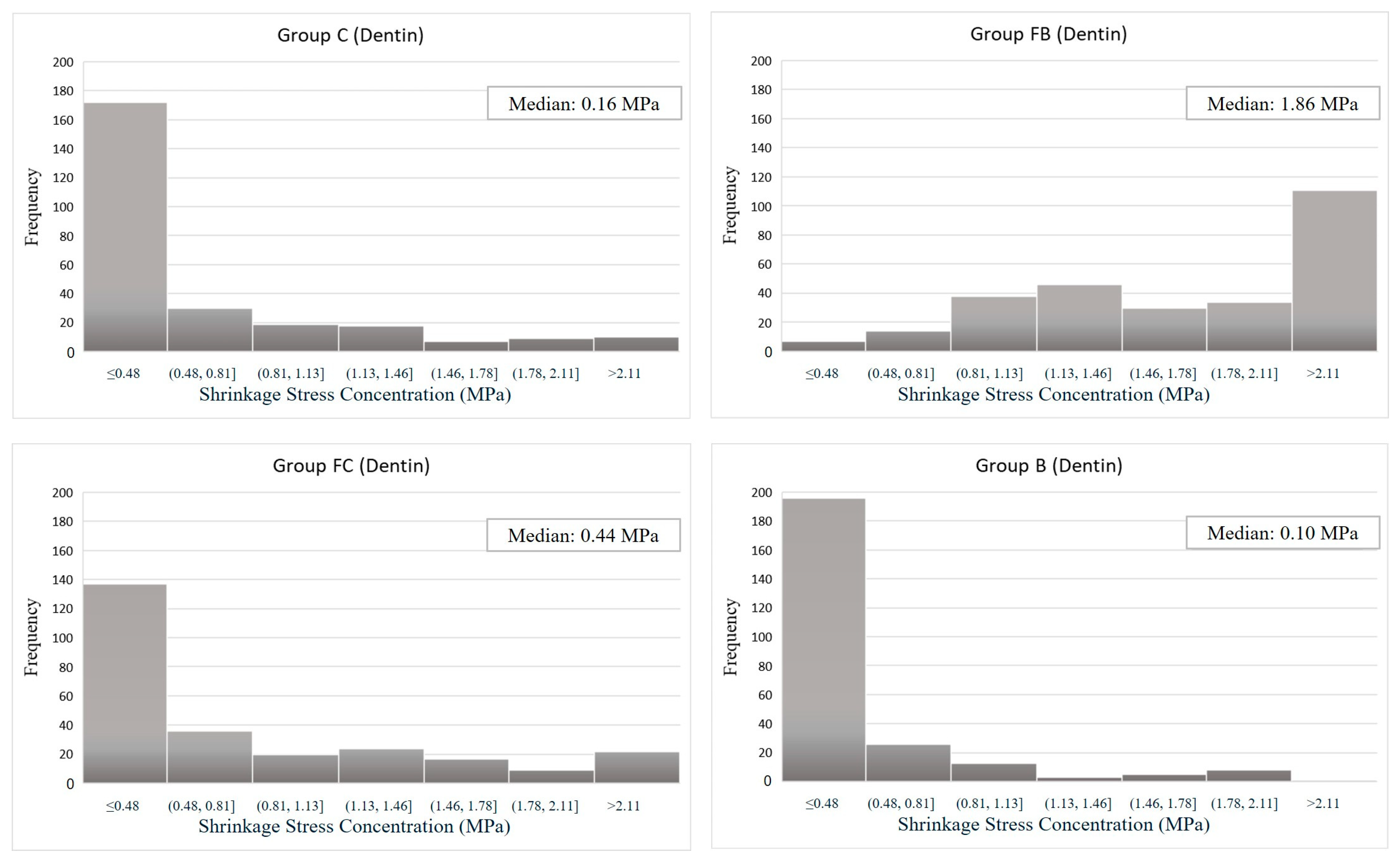Evaluation of Internal and Marginal Shrinkage Stress in Adhesive Class III Cavities Restored with Different Resin Composite Combinations—A 3D-FEA Study
Abstract
1. Introduction
2. Materials and Methods
3. Results
4. Discussion
5. Conclusions
- -
- The FB group (flowable bulk-fill base + two conventional increments) showed the highest internal dentin stress, suggesting a potentially higher risk of adhesive degradation in clinical conditions.
- -
- The C and B groups, which avoided flowables and used either conventional or bulk-fill resins with limited increments, showed the lowest stress concentrations in both dentin and enamel.
- -
- The use of a low-modulus flowable base, as in FB and FC, was associated with greater internal stress, likely due to elastic mismatch and shrinkage behavior.
- -
- All techniques showed high-frequency stress concentration at the enamel cavo-surface bevel, mainly due to the modulus difference between enamel and resin composite.
Author Contributions
Funding
Institutional Review Board Statement
Informed Consent Statement
Data Availability Statement
Conflicts of Interest
References
- Shah, Y.R.; Shiraguppi, V.L.; Deosarkar, B.A.; Shelke, U.R. Long-term survival and reasons for failure in direct anterior composite restorations: A systematic review. J. Conserv. Dent. 2021, 24, 415–420. [Google Scholar] [CrossRef]
- Demarco, F.F.; Collares, K.; Correa, M.B.; Cenci, M.S.; Moraes, R.R.; Opdam, N.J. Should my composite restorations last forever? Why are they failing? Braz. Oral Res. 2017, 31 (Suppl. S1), e56. [Google Scholar] [CrossRef]
- Demarco, F.F.; Collares, K.; Coelho-de-Souza, F.H.; Correa, M.B.; Cenci, M.S.; Moraes, R.R.; Opdam, N.J. Anterior composite restorations: A systematic review on long-term survival and reasons for failure. Dent. Mater. 2015, 31, 1214–1224. [Google Scholar] [CrossRef]
- Ausiello, P.; Ciaramella, S.; De Benedictis, A.; Lanzotti, A.; Tribst, J.P.M.; Watts, D.C. The use of different adhesive filling material and mass combinations to restore class II cavities under loading and shrinkage effects: A 3D-FEA. Comput. Methods Biomech. Biomed. Eng. 2021, 24, 485–495. [Google Scholar] [CrossRef]
- Soares, C.J.; Faria-E-Silva, A.L.; Rodrigues, M.P.; Vilela, A.B.F.; Pfeifer, C.S.; Tantbirojn, D.; Versluis, A. Polymerization shrinkage stress of composite resins and resin cements—What do we need to know? Braz. Oral Res. 2017, 31 (Suppl. S1), e62. [Google Scholar] [CrossRef]
- Zeiger, D.N.; Sun, J.; Schumacher, G.E.; Lin-Gibson, S. Evaluation of dental composite shrinkage and leakage in extracted teeth using X-ray microcomputed tomography. Dent. Mater. 2009, 25, 1213–1220. [Google Scholar] [CrossRef] [PubMed]
- Khan, M.A.; Delgado, A.H.; Young, A.M. Modifying dental composites to formulate novel methacrylate-based bone cements with improved polymerisation kinetics, and mechanical properties. Dent. Mater. 2023, 39, 1067–1075. [Google Scholar] [CrossRef] [PubMed]
- Al Sunbul, H.; Silikas, N.; Watts, D.C. Polymerization shrinkage kinetics and shrinkage-stress in dental resin-composites. Dent. Mater. 2016, 32, 998–1006. [Google Scholar] [CrossRef]
- Leyva Del Rio, D.; Johnston, W.M. Effect of monomer composition and filler fraction on surface microhardness and depth of cure of experimental resin composites. Eur. J. Oral Sci. 2023, 131, e12933. [Google Scholar] [CrossRef] [PubMed]
- Fugolin, A.P.; de Paula, A.B.; Dobson, A.; Huynh, V.; Consani, R.; Ferracane, J.L.; Pfeifer, C.S. Alternative monomer for BisGMA-free resin composites formulations. Dent. Mater. 2020, 36, 884–892. [Google Scholar] [CrossRef]
- Yang, J.; Silikas, N.; Watts, D.C. Polymerization and shrinkage kinetics and fracture toughness of bulk-fill resin-composites. Dent. Mater. 2022, 38, 1934–1941. [Google Scholar] [CrossRef] [PubMed]
- Rizzante, F.A.P.; Mondelli, R.F.L.; Furuse, A.Y.; Borges, A.F.S.; Mendonça, G.; Ishikiriama, S.K. Shrinkage stress and elastic modulus assessment of bulk-fill composites. J. Appl. Oral Sci. 2019, 27, e20180132. [Google Scholar] [CrossRef]
- Rizzante, F.A.P.; Duque, J.A.; Duarte, M.A.H.; Mondelli, R.F.L.; Mendonça, G.; Ishikiriama, S.K. Polymerization shrinkage, microhardness and depth of cure of bulk fill resin composites. Dent. Mater. J. 2019, 38, 403–410. [Google Scholar] [CrossRef]
- Zorzin, J.; Maier, E.; Harre, S.; Fey, T.; Belli, R.; Lohbauer, U.; Petschelt, A.; Taschner, M. Bulk-fill resin composites: Polymerization properties and extended light curing. Dent. Mater. 2015, 31, 293–301. [Google Scholar] [CrossRef]
- Ausiello, P.; Ciaramella, S.; Lanzotti, A.; Ventre, M.; Borges, A.L.; Tribst, J.P.; Dal Piva, A.; Garcia-Godoy, F. Mechanical behavior of Class I cavities restored by different material combinations under loading and polymerization shrinkage stress. A 3D-FEA study. Am. J. Dent. 2019, 32, 55–60. [Google Scholar]
- Kaisarly, D.; Langenegger, R.; Litzenburger, F.; Heck, K.; El Gezawi, M.; Rösch, P.; Kunzelmann, K.H. Effects of application method on shrinkage vectors and volumetric shrinkage of bulk-fill composites in class-II restorations. Dent. Mater. 2022, 38, 79–93. [Google Scholar] [CrossRef]
- Tsujimoto, A.; Jurado, C.A.; Barkmeier, W.W.; Sayed, M.E.; Takamizawa, T.; Latta, M.A.; Miyazaki, M.; Garcia-Godoy, F. Effect of Layering Techniques on Polymerization Shrinkage Stress of High- and Low-viscosity Bulk-fill Resins. Oper. Dent. 2020, 45, 655–663. [Google Scholar] [CrossRef]
- Van Ende, A.; De Munck, J.; Lise, D.P.; Van Meerbeek, B. Bulk-Fill Composites: A Review of the Current Literature. J. Adhes. Dent. 2017, 19, 95–109. [Google Scholar] [PubMed][Green Version]
- Ferracane, J.L. Resin-based composite performance: Are there some things we can’t predict? Dent. Mater. 2013, 29, 51–58. [Google Scholar] [CrossRef]
- Rubin, C.; Krishnamurthy, N.; Capilouto, E.; Yi, H. Stress analysis of the human tooth using a three-dimensional finite element model. J. Dent. Res. 1983, 62, 82–86. [Google Scholar] [CrossRef] [PubMed]
- Dejak, B.; Młotkowski, A. A comparison of stresses in molar teeth restored with inlays and direct restorations, including polymerization shrinkage of composite resin and tooth loading during mastication. Dent. Mater. 2015, 31, e77–e87. [Google Scholar] [CrossRef] [PubMed]
- Tribst, J.P.M.; Dal Piva, A.M.O.; Ausiello, P.; De Benedictis, A.; Bottino, M.A.; Borges, A.L.S. Biomechanical Analysis of a Custom-Made Mouthguard Reinforced With Different Elastic Modulus Laminates During a Simulated Maxillofacial Trauma. Craniomaxillofac. Trauma Reconstr. 2021, 14, 254–260. [Google Scholar] [CrossRef]
- Singh, S.V.; Bhat, M.; Gupta, S.; Sharma, D.; Satija, H.; Sharma, S. Stress distribution of endodontically treated teeth with titanium alloy post and carbon fiber post with different alveolar bone height: A three-dimensional finite element analysis. Eur. J. Dent. 2015, 9, 428–432. [Google Scholar] [CrossRef] [PubMed]
- Martins, L.C.; Oliveira, L.R.S.; Braga, S.S.L.; Soares, C.J.; Versluis, A.; Borges, G.A.; Veríssimo, C. Effect of Composite Resin and Restorative Technique on Polymerization Shrinkage Stress, Cuspal Strain and Fracture Load of Weakened Premolars. J. Adhes. Dent. 2020, 22, 503–514. [Google Scholar]
- Sun, T.; Shao, B.; Liu, Z. Effects of the lining material, thickness and coverage on residual stress of class II molar restorations by multilayer technique. Comput. Methods Programs Biomed. 2021, 202, 105995. [Google Scholar] [CrossRef]
- Yadav, V.; Roongta, R.N.; Yadav, S.; Talwar, S. Effect of C-factor on Micro-tensile Bond Strength of Bulk fill V/S Micro-hybrid Composite in Class II Restorations—An In-Vitro Study. Niger. Med. J. 2022, 63, 112–120. [Google Scholar]
- Borges, A.L.; Borges, A.B.; Xavier, T.A.; Bottino, M.C.; Platt, J.A. Impact of quantity of resin, C-factor, and geometry on resin composite polymerization shrinkage stress in Class V restorations. Oper. Dent. 2014, 39, 144–151. [Google Scholar] [CrossRef]
- Bicalho, A.A.; Valdívia, A.D.; Barreto, B.C.; Tantbirojn, D.; Versluis, A.; Soares, C.J. Incremental filling technique and composite material—Part II: Shrinkage and shrinkage stresses. Oper. Dent. 2014, 39, E83–E92. [Google Scholar] [CrossRef]
- Kalakijuybari, F.Z.; Pasdar, N.; Ahmadi, G.; Seyedmajidi, A. Investigating the impact of flowable composite liner on the fracture strength and microleakage of large composite resin restorations of primary anterior teeth. Eur. Arch. Paediatr. Dent. 2023, 24, 473–479. [Google Scholar] [CrossRef] [PubMed]
- Boruziniat, A.; Gharaee, S.; Sarraf Shirazi, A.; Majidinia, S.; Vatanpour, M. Evaluation of the efficacy of flowable composite as lining material on microleakage of composite resin restorations: A systematic review and meta-analysis. Quintessence Int. 2016, 47, 93–101. [Google Scholar]
- Ferracane, J.L.; Hilton, T.J. Polymerization stress—Is it clinically meaningful? Dent. Mater. 2016, 32, 1–10. [Google Scholar] [CrossRef]
- Baroudi, K.; Saleh, A.B.; Silikas, N.; Watts, D.W. Shrinkage behaviour of flowable resin-composites related to conversion and filler-fraction. Dent. Mater. 2007, 35, 651–655. [Google Scholar] [CrossRef] [PubMed]
- Kunz, P.V.M.; Wambier, L.M.; Kaizer, M.D.R.; Correr, G.M.; Reis, A.; Gonzaga, C.C. Is the clinical performance of composite resin restorations in posterior teeth similar if restored with incremental or bulk-filling techniques? A systematic review and meta-analysis. Clin. Oral Investig. 2022, 26, 2281–2297. [Google Scholar] [CrossRef]
- Bicalho, A.A.; Pereira, R.D.; Zanatta, R.F.; Franco, S.D.; Tantbirojn, D.; Versluis, A.; Soares, C.J. Incremental filling technique and composite material—Part I: Cuspal deformation, bond strength, and physical properties. Oper. Dent. 2014, 39, E71–E82. [Google Scholar] [CrossRef]
- Perdigão, J.; Araujo, E.; Ramos, R.Q.; Gomes, G.; Pizzolotto, L. Adhesive dentistry: Current concepts and clinical considerations. J. Esthet. Restor. Dent. 2021, 33, 51–68. [Google Scholar] [CrossRef]
- Buonocore, M.G. A simple method of increasing the adhesion of acrylic filling materials to enamel surfaces. J. Dent. Res. 1955, 34, 849–853. [Google Scholar] [CrossRef]
- Fang, M.; Liu, R.; Xiao, Y.; Li, F.; Wang, D.; Hou, R.; Chen, J. Biomodification to dentin by a natural crosslinker improved the resin-dentin bonds. J. Dent. 2012, 40, 458–466. [Google Scholar] [CrossRef]
- Feilzer, A.J.; de Gee, A.J.; Davidson, C.L. Setting stresses in composites for two different curing modes. Dent. Mater. 1993, 9, 2–5. [Google Scholar] [CrossRef] [PubMed]
- Feilzer, A.J.; Dooren, L.H.; de Gee, A.J.; Davidson, C.L. Influence of light intensity on polymerization shrinkage and integrity of restoration-cavity interface. Eur. J. Oral Sci. 1995, 103, 322–326. [Google Scholar] [CrossRef] [PubMed]
- Chandrasekhar, V.; Rudrapati, L.; Badami, V.; Tummala, M. Incremental techniques in direct composite restoration. J. Conserv. Dent. 2017, 20, 386–391. [Google Scholar] [CrossRef]
- Ouldyerou, A.; Mehboob, H.; Mehboob, A.; Merdji, A.; Aminallah, L.; Mukdadi, O.M.; Barsoum, I.; Junaedi, H. Biomechanical performance of resin composite on dental tissue restoration: A finite element analysis. PLoS ONE 2023, 18, e0295582. [Google Scholar] [CrossRef] [PubMed]
- Ferracane, J.L. A Historical Perspective on Dental Composite Restorative. Materials. J. Funct. Biomater. 2024, 15, 173. [Google Scholar] [CrossRef] [PubMed]





| Material | Elastic Modulus (GPa) | Poisson’s Ratio | Thermal Expansion Coefficients | Reference |
|---|---|---|---|---|
| Enamel | 84.1 | 0.30 | --- | [20] |
| Dentin | 18.6 | 0.31 | --- | [20] |
| Pulp | 0.002 | 0.45 | --- | [22] |
| Ligament | 0.069 | 0.45 | --- | [23] |
| Cortical Bone | 13.7 | 0.3 | --- | [22] |
| Medullary Bone | 1.4 | 0.3 | --- | [22] |
| Filtek Z350 XT | 13.45 | 0.17 | 0.00033 | [24] |
| Bulk Fill Z350 | 13.46 | 0.18 | 0.00025 | [24] |
| Bulk Fill Flow Z350 | 7.98 | 0.32 | 0.00047 | [25] |
| Group | Group | Group | Group | |
|---|---|---|---|---|
| Layer | B | C | FB | FC |
| 1 | 28.68 mm3 Bulk Fill Z350 (E = 13.46 GPa) | 13.77 mm3 Filtek Z350 (E = 13.45 GPa) | 13.21 mm3 Bulk Fill Flow Z350 (E = 7.95 GPa) | 13.21 mm3 Bulk Fill Flow Z350 (E = 7.95 GPa) |
| 2 | 18.67 mm3 Filtek Z350xt (E = 13.45 GPa) | 14.91 mm3 Filtek Z350 (E = 13.45 GPa) | 15.47 mm3 Filtek Z350 (E = 13.45 GPa) | 8.36 mm3 Filtek Z350 (E = 13.45 GPa) |
| 3 | ---- | 18.67 mm3 Filtek Z350 (E = 13.45 GPa) | 18.67 mm3 Filtek Z350 (E = 13.45 GPa) | 7.11 mm3 Filtek Z350 (E = 13.45 GPa) |
| 4 | ---- | ---- | ---- | 18.67 mm3 Filtek Z350 (E = 13.45 GPa) |
| Total | 47.35 mm3 | 47.35 mm3 | 47.35 mm3 | 47.35 mm3 |
| Group | Enamel | Dentin |
| C (2 INC Filtek Z350 XT) | 7.6 MPa | 2.9 MPa |
| B (1 INC Bulk Fill Z350 + 2 INC Filtek Z350 XT) | 7.6 MPa | 2.3 MPa |
| FC (1INC Bulk Fill Flow Z350 + 3 INC Filtek Z350 XT) | 9.2 MPa | 4.1 MPa |
| FB (1INC Bulk Fill Flow Z350 + 2 INC Filtek Z350 XT) | 10.3 MPa | 4.2 MPa |
Disclaimer/Publisher’s Note: The statements, opinions and data contained in all publications are solely those of the individual author(s) and contributor(s) and not of MDPI and/or the editor(s). MDPI and/or the editor(s) disclaim responsibility for any injury to people or property resulting from any ideas, methods, instructions or products referred to in the content. |
© 2025 by the authors. Licensee MDPI, Basel, Switzerland. This article is an open access article distributed under the terms and conditions of the Creative Commons Attribution (CC BY) license (https://creativecommons.org/licenses/by/4.0/).
Share and Cite
Grassi, E.D.A.; de Andrade, G.S.; de Carvalho, A.B.G.; Gasparro, R.; Mariniello, M.; Aliberti, A.; Ausiello, P.; Borges, A.L.S. Evaluation of Internal and Marginal Shrinkage Stress in Adhesive Class III Cavities Restored with Different Resin Composite Combinations—A 3D-FEA Study. Dent. J. 2025, 13, 367. https://doi.org/10.3390/dj13080367
Grassi EDA, de Andrade GS, de Carvalho ABG, Gasparro R, Mariniello M, Aliberti A, Ausiello P, Borges ALS. Evaluation of Internal and Marginal Shrinkage Stress in Adhesive Class III Cavities Restored with Different Resin Composite Combinations—A 3D-FEA Study. Dentistry Journal. 2025; 13(8):367. https://doi.org/10.3390/dj13080367
Chicago/Turabian StyleGrassi, Elisa Donaria Aboucauch, Guilherme Schmitt de Andrade, Ana Beatriz Gomes de Carvalho, Roberta Gasparro, Mauro Mariniello, Angelo Aliberti, Pietro Ausiello, and Alexandre Luiz Souto Borges. 2025. "Evaluation of Internal and Marginal Shrinkage Stress in Adhesive Class III Cavities Restored with Different Resin Composite Combinations—A 3D-FEA Study" Dentistry Journal 13, no. 8: 367. https://doi.org/10.3390/dj13080367
APA StyleGrassi, E. D. A., de Andrade, G. S., de Carvalho, A. B. G., Gasparro, R., Mariniello, M., Aliberti, A., Ausiello, P., & Borges, A. L. S. (2025). Evaluation of Internal and Marginal Shrinkage Stress in Adhesive Class III Cavities Restored with Different Resin Composite Combinations—A 3D-FEA Study. Dentistry Journal, 13(8), 367. https://doi.org/10.3390/dj13080367










